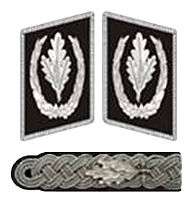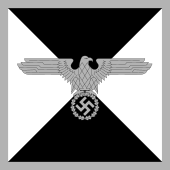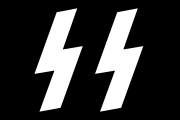Reichsführer-SS
- See Reichsführer-SS (film) for the 2015 motion picture



Reichsführer-SS (German: [ˈʁaɪçsˌfyːʁɐ ˈɛs ˈɛs]) was a special title and rank that existed between the years of 1925 and 1945 for the commander of the Schutzstaffel (SS). Reichsführer-SS was a title from 1925 to 1933, and from 1934 to 1945 it was the highest rank of the SS. The longest serving and by far most noteworthy Reichsführer-SS was Heinrich Himmler.
Definition
Reichsführer-SS was both a title and a rank. The title of Reichsführer was first created in 1926 by the second commander of the SS, Joseph Berchtold. Berchtold's predecessor, Julius Schreck, never referred to himself as Reichsführer, but the title was retroactively applied to him in later years. In 1929, Heinrich Himmler became Reichsführer-SS and referred to himself by his title instead of his regular SS rank of Obergruppenführer. This set the precedent for the commander of the SS to be called Reichsführer-SS.
Prior to the Night of the Long Knives, the SS was an elite corps of the Sturmabteilung (SA or storm troopers), and the Reichsführer-SS was subordinate to the SA's operating head, the Stabschef. On 20 July 1934, as part of the purge of the SA, the SS was made an independent branch of the Nazi Party, responsible only to Hitler. From that point on, the title of Reichsführer-SS became an actual rank, and in fact the highest rank of the SS.[1] In this position, Himmler was on paper the equivalent of a Generalfeldmarschall in the German Army. As Himmler's position and authority grew in Nazi Germany, so did his rank in a "de facto" sense.[2] Further, there was never more than one Reichsführer-SS at any one time, with Himmler holding the position as his personal title from 1929 (becoming his actual rank in 1934) until April 1945.[3]
Duties
Under its original inception, the rank of Reichsführer-SS was the designation for the head of the Allgemeine-SS. In this capacity, the SS Reich Leader was the direct commander of the SS Senior District Leaders (SS-Oberabschnitt Führer); by 1935, the Reich Leader was further designated as head of the three main SS branches: the Allgemeine-SS (General-SS), SS-Verfügungstruppe (SS-VT; Political Action Troops), and the SS-Totenkopfverbände (SS-TV; Concentration Camp Service). The Reichsführer-SS was also the designated senior officer for all the SS Main Office Leaders.
During the Second World War, the Reichsführer-SS in effect held several additional roles and wielded enormous personal power. He was responsible for all internal security within the Third Reich. He was overseer of the concentration camps, extermination camps (through the Concentration Camps Inspectorate and SS-TV), and Einsatzgruppen (through the RSHA).[4] Over time, his influence on both civil and foreign policy became marked, as the Reichsführer reported directly to Hitler and his actions were not tempered by checks and balances. This meant the office holder could implement broad policy such as the Final Solution, or order criminal acts such as the Stalag Luft III murders, without impediment.
It is difficult to separate the office from the duties assigned to the individual. As of 20 April 1934, Himmler in his position of Reichsführer-SS already controlled the SD and Gestapo. On 17 June 1936 Himmler was named chief of all German police, thereby placing all uniformed police (Orpo) and criminal police (Kripo) in Germany under his control. In the latter role, he was nominally subordinate to the Interior Minister, Wilhelm Frick.[5] It is not clear how much of this power would technically reside in the office of the Reichsführer-SS were those duties to be split up.[Note 1] These questions became moot by the time Himmler became the Interior Minister in 1943.
It is difficult to define precisely the full detailed duties and responsibilities of the Reichsführer-SS beyond that of leader and senior member of the SS, since, in the words of one historian, "(b)y the outbreak of the (Second World) war it would have been impossible to define exactly the role within the state" of the entire SS itself.[6]
Relationship with the Waffen-SS
The rank of Reichsführer-SS was defined in the SS hierarchy as the highest possible rank of the Allgemeine-SS. The exact position of the rank within the military Waffen-SS evolved over many years, ranging from clearly defined to vaguely associated. The Waffen-SS was originally a small armed SS unit called the SS-Verfügungstruppe, and in the 1930s was clearly under the command of Himmler who, in his position as Reichsführer-SS, issued directives and orders to SS-VT commanders. Hold-outs existed for some aspects of the armed SS however, as well as within the special bodyguard unit known as the SS-Leibstandarte. Sepp Dietrich, since the earliest inception of an armed SS unit, never truly accepted Himmler's authority and in the mid-1930s went so far as to order his troops to remove their swastika armbands as well as forbidding General-SS members (Himmler among them) from entering the Leibstandarte barracks.
The Waffen-SS eventually grew from three regiments to over 38 divisions and served alongside the German Army, but was never formally part of it.[7] During World War II, the authority of the Reichsführer-SS over the Waffen-SS was mainly administrative in that certain General-SS offices controlled supply and logistics aspects of the Waffen-SS. Himmler also held authority to create new Waffen-SS divisions as well as order the formation of various smaller SS combat units. The daily association with the Waffen-SS, however, encompassed primarily inspecting Waffen-SS troops and presenting high-ranking medals to its members.
The Reichsführer-SS further never exercised direct operational authority over Waffen-SS units until the very end of the war and then only through his capacity as an Army Group commander and not as the head of the SS. Top Waffen-SS commanders, such as Sepp Dietrich, Wilhelm Bittrich, and Matthias Kleinheisterkamp, further held a certain derision for Himmler, describing him as "sly and unmilitary". The Waffen-SS rank and file also saw the Reichsführer as an odd character, present at high level parades and formations, but of little use to the Waffen-SS operational chain of command. As a further act of indifference, Himmler was known by the nickname "Reichsheini" among Waffen-SS soldiers.
Himmler's rank of Reichsführer was also not seen as a military superior rank of the Waffen-SS, and as such there was no operational equivalent to the rank of field marshal in the armed SS hierarchy. In the very last months of the war, a proposal was made for a new SS rank to be known as Volksmarschall, with this new rank being a Waffen-SS direct equivalent to the army and air force rank of field marshal. Sepp Dietrich was considered for the rank, but due to the looming defeat of the war the rank was never presented nor even an insignia designed.
Kommandostab Reichsführer-SS
Attached to the office was the 18,438-strong SS formations managed by the Kommandostab Reichsführer-SS ("Command Staff Reichsführer-SS") reporting directly to Himmler. To head the Command Staff, Himmler appointed a career army officer Kurt Knoblauch who acted as chief of staff for the units.[8] Prior to the launch of the invasion of the Soviet Union in June 1941, these formations included two motorized SS-Infantry Brigades, two SS-Cavalry Regiments combined with an SS-Cavalry Brigade, a bodyguard battalion, flak units and a number of companies of support troops. Units were temporarily placed under Heer command for operations, but the Reichsführer could call them back at any time. Despite the name, it was not employed as a unified HQ unit. Instead, its individual units were sent to occupied areas, subordinated to local Higher SS and Police Leaders (HSSPFs) and used for "pacification actions" alongside the Einsatzgruppen. Often these actions were atrocities and mass murders, targeting Jews and "suspected partisans".[9]
Office holders
In all, five people held the title of Reichsführer-SS during the twenty years of its existence. Three persons held the position as a title while two held the actual SS rank.
- Julius Schreck (1925–1926)[10]
- Joseph Berchtold (1926–1927)[10]
- Erhard Heiden (1927–1929)[10]
- Heinrich Himmler (1929–1945)[10]
- Karl Hanke (1945)[10]
Hanke was appointed SS leader in April 1945, but not informed until early May. He was killed on June 8, 1945, while attempting to escape a Czech POW camp. Historians have often speculated that Reinhard Heydrich would have eventually held the rank had Himmler in some way been killed or removed from his position earlier in World War II, and indeed Heydrich was often seen as Himmler's heir apparent by senior SS leaders. However, at a diplomatic function in Italy in 1941, Heydrich was reported as stating that he had no desire to succeed Himmler.[11]
In popular culture
The rank of Reichsführer-SS has also appeared in fiction with the following some of the more notable examples:
- In the Robert Harris novel Fatherland, set in a parallel history where Germany won the Second World War, Reinhard Heydrich is depicted as having been promoted to the rank of the Reichsführer-SS, after Himmler was mysteriously killed in a plane crash in 1962. While the novel dealt with Heydrich's assumption of the rank at some length, the HBO film adaptation gives little reference to this. In the film, the only indication of Heydrich as the Reichsführer-SS is a quick three-second shot of a non-speaking extra (intended to be Heydrich), seen wearing a grey SS uniform standing on a VIP-platform with several German generals.
- The Star Trek episode "Patterns of Force" depicts an alien planet where a historian has recreated Nazi Germany in an attempt to form a benign fascist government marked by efficiency without sadism. In the episode, during a speech given by John Gill, the Federation historian turned Führer, a top SS general is seen wearing the complete uniform and insignia of the Reichsführer-SS. This character is not given a name in the episode, nor does he speak any dialogue. The Star Trek Reichsführer was portrayed by actor Frank da Vinci.
- Himmler appears as Reichsführer-SS, visiting a conquered Britain in November 1941, in the Len Deighton alternate history novel SS-GB.
- In Harry Turtledove's novel Colonization: Second Contact, Himmler is depicted as succeeding Hitler as Führer, and continuing to rule Nazi Germany until his own death in the 1960s.
- In another of Harry Turtledove's novels In the Presence of Mine Enemies, one of the antagonists is the Reichsführer-SS Lothar Prützmann, who attempts to overthrow the new Führer, Heinz Buckliger. In the backstory, Himmler succeeded Hitler as Führer.
- The Reichsführer-SS (Heinrich Himmler) appears in the film The Aryan Couple (2004).
- In the '60's sitcom Hogan's Heroes, two officers, Rudolf von Heffernick and Herman Freitag, wear the insignia of a Reichsführer-SS on their uniforms. Von Heffernick is stated to be a general by Colonel Klink, but what exact rank is unstated. Freitag is addressed explicitly in dialogue as a Gruppenführer, which would make him a major general.
Notes
- ↑ As noted in, The SS (Time-Life, pp. 70-73.): "Himmler...was now the head of two important, separate organizations - the SS and the national police (emphasis added)." Much of his power and influence as Reichsführer-SS resided from control of the police, duties separate, yet linked.
References
Citations
- ↑ Kershaw 2008, p. 316.
- ↑ McNab 2009, pp. 9, 17, 26-27, 30, 46-47.
- ↑ McNab 2009, pp. 9, 17.
- ↑ McNab 2009, pp. 9, 35-36, 46-47.
- ↑ McNab 2009, pp. 9, 46-47.
- ↑ Windrow 1982, p. 7.
- ↑ McNab 2009, pp. 9, 35-36, 46-47, 61, 64, 66-70.
- ↑ Hale 2011, p. 160–162.
- ↑ Stein 1984.
- 1 2 3 4 5 McNab 2009, pp. 16, 17.
- ↑ Yerger 1997.
Bibliography
- Flaherty, T. H. (1988). The Third Reich: The SS. Time-Life Books, Inc. ISBN 0-8094-6950-2.
- Hale, Christopher (2011). Hitler's Foreign Executioners: Europe's Dirty Secret. The History Press. ISBN 978-0-7524-5974-5.
- Kershaw, Ian (2008). Hitler: A Biography. New York: W. W. Norton & Company. ISBN 978-0-393-06757-6.
- McNab, Chris (2009). The SS: 1923–1945. Amber Books Ltd. ISBN 978-1-906626-49-5.
- Stein, George H. (1984). The Waffen SS: Hitler's Elite Guard at War, 1939–1945. Ithaca, NY: Cornell University Press. ISBN 0-8014-9275-0.
- Windrow, Martin (1982). The Waffen-SS. Osprey Publishing. ISBN 0-85045-425-5.
- Yerger, Mark C. (1997). Allgemeine-SS: The Commands, Units and Leaders of the General SS. Schiffer Publishing Ltd. ISBN 0-7643-0145-4.
| Junior Rank Oberstgruppenführer |
SS rank Reichsführer-SS |
Senior Rank Oberste Führer der Schutzstaffel |

